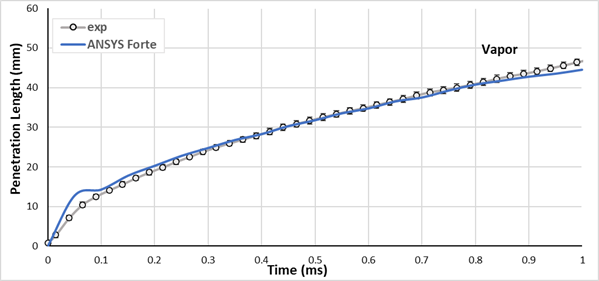VMFRT005
VMFRT005
Engine Combustion Network Reacting Flow Case jkldaAL4
Overview
| Reference | Retrieved from Engine Combustion Network data search utility: https://ecn.sandia.gov/ecn-data-search/ Accessed on April 7, 2020. Find relevant data and information by choosing the parameters highlighted in gray below on the ECN data search utility.  |
| Solver | Ansys Forte |
| Physics/Models | Engine Combustion Network (ECN) Nonreacting Flow Case jkldaAL4 |
| Input Files | P_150MPa_R.ftsim |
| Project Files | Link to Project Files Download Page |
Test Case
This test recreates the Engine Combustion Network (ECN) Spray A target case characterized by high-pressure liquid fuel injection in conditions relevant to diesel engines. In this case, the combustion chamber has a cubical shape (length = 10.8 cm), the oxygen content is 15%, and the difference between the fuel injector pressure and ambient gas pressure is 150 MPa. The fuel entering the combustion chamber through the spray injector is n-dodecane (nC12).
The model includes two refined regions of respectively 2 mm and 1 mm around the jet. The table below lists the setup parameters for the experiment and simulation. No liquid penetration length measurements were found on the ECN repository for this case, but experimental data for the vapor penetration length can be found on the ECN site in the form of a text file:
The modeling prediction for vapor penetration length is compared with the experimental results including error bars in Figure 206: Vapor and liquid penetration length. Additional measurements on the ECN data search utility report the lift-off length measurement and the ignition delay time. The slight overprediction is likely due to imperfections in the low temperature chemical kinetics of the reacting fuel and air mixture.
| Test case properties | |||||||||
|---|---|---|---|---|---|---|---|---|---|
| Pinj | Minj | Durationinj | Vamb | ρamb | Compositionamb | Pamb | Tamb | Tfuel | Dnozzle |
| 150 MPa | 14 mg | 6 ms | 20 cm/s | 22.8 kg/m3 | N2 = 75.15% CO2 = 6.22% H2O = 3.62% O2 = 15.00% | 5.94 MPa | 900 K | 373 K | 0.084 mm |
| Simulation Settings | |||||||||
| RTdist | vinj profile | Spray initialization model | L/D | R/D | SAM on ∇T∇Vel∇Y*[a] | Turbulence model | Mesh sizeMAX | dtinitial | |
| 2.2 | Flat | Nozzle flow | 11.9 | 0.238 | 0.5 mm | RANS RNG-ke | 4 mm | 1E-7 s | |
[a] Y*=Fuel Vapor Mass Fraction



